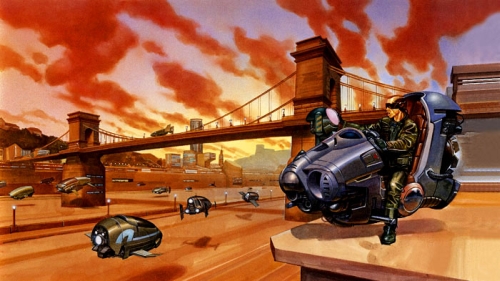Somehow I feel really pissed that there is not much to be seen by this incredible cult duo of Hungarian illustrators (one of them, Gábor Szikszai lives in LA to my knowledge working inside the gaming industry). I tried to trace as much as I could about their work – altough I do not have the least knowledge in Hungarian language I managed to dig up a few things. Both seem to embody the best of the 80s- 90s, somehow combing pulpy-glossy, realist imagery, feeling like airbrush and looking like VHS tape covers. They did some great futuristic cityscapes (including a lot of fantasy character work & magicpunk game cards). Here I want to mostly focus on their proper SF work and tell you how I found out about them.
I stumbled on their work via this incredibly nice panorama coverart work for Sector General cycle in its German translation. I would love to print out this panoramic view inside my room so one could actually sit inside the station looking outside – surrounded on all side by this picture. In fact if you collected or read all the books in the series – in the end you could complete this puzzle of an orbital galactic Hospital – the centerpiece of James White’s Sector General series. James White is a Northern Irish SF author that settles the majority of his stories and novel around Sector 12 General Hospital – an immense floating hospital station located in deep space. It is widely considered the first explicitly pacifist space opera (published from 1957 onward) in a stark contrast with contemporary US space operas, which were generally militaristic. In fact the station is seen from. The start as an ideal way to make peaceful first contact possible between very different alien species. Each section of the station is like the ISS a patchwork of various habitat each ward customized to the metabolic, chemical, anatomic requirements of its patients. Taking into account gravity, atmospheric pressure, respiratory needs (if respiration is your thing). White’s hate of war and xenophobia is an important feature driving the whole series. His ability to make goodness – interesting, moving and actionable (instead of battles, destruction, invasions etc) is quite unique. In fact he loathed violence so much that the only violence was that of planetary catastrophes, accidents, surgery rooms or emergency situations. It presents us with a credible and believable version of altruistic space doctors that work towards establishing xenobiological mutualistic or symbiotic relationships.
A few notes of the Hungarian Galaktika(1972-1995) SF mag where Gábor Szikszai duo published some of their early work) – like most of the East European, ex-Socialist countries, SF was a true mass phenomenon not a niche thing. The more I find out about the specific publications and distro histories of neighboring countries of Bulgaria and Hungary (as well as what I gather from my own experience with Romanian SF publications), the more I realize how deeply enjoyed and widely spread were ideas discussed by SF mags or anthologies, how diverse the available range of translations and how wide the outreach of these magazines was. I heard an anecdote about how the Bulgarian translation of Dune became the talk of the town. From the kids at school to the ladies selling flowers or the engineers on scaffolding of construction sites (this is a story I heard from Bulgarian historians of SF). Of course a lot of these mags plummeted after 1990, and their fortunes went up and down along the years. Of course a lot of East European ‘talent’, some of its best illustrators made it way towards better payed, more prestigious venues, starting their studios or continuing to work for the US or German video gaming or card board game market. At the peak of its popularity Galaktika had a print run of 94,000 copies (for a population of 10 million).
It is really hard to track the work of Boros Szikszai online and there is not a lot of archival materials so I am thankful for everybody that scanned or made available (not least to them!) their amazing work. I appreciate their airbrush style that reminds me somehow of the best of lonf 80s and 1990s, the slick chrome artwork of Japanese illustrator Hajime Sorayama without the explicit pinup poses or how they pushed Syd Meadesque cityscapes towards a cyberpunk straight-to-VHS or straight-to-DVD 90s trashy kind of look. I also like the fact that they made a lot of futuristic ads using the picturesque Budapest Danube shoreline, always quite recognizable in their 90s work. They even have a pretty cool dystopian Budapest cityscape. Sadly a lot of their SF and cyberpunk work is very hard to find online (most is just magic card decks and WoW).

Official Gábor Szikszai website
An article in Hungarian about their work (had to use Google translate but has lots of links)

